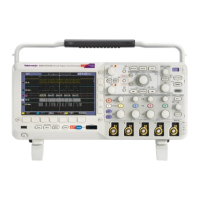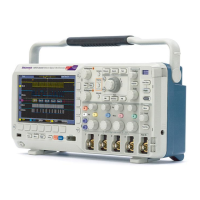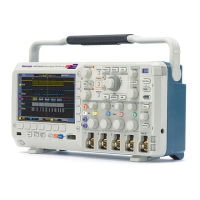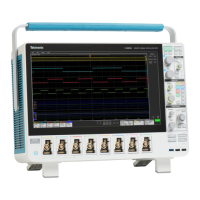Analyze Wavefor
mData
Set up the FFT so that the Nyquist frequency is above the major frequency components of your signal. To do this, adjust
the Horizontal
time/div, which affects the Nyquist frequency.
Use the Filter
Vu low-pass filter to remove aliases from the source waveform. To do this, set the filter frequency to its
minimum value (while zoom is off and acquisitions are running). Aliased frequencies are reduced to no more than 1% of
their o riginal amplitude. Using a filter frequency above the minimum can reduce, but not eliminate, aliasing.
Recognize and ignore the aliased frequencies.
NOTE. The Nyq
uist frequency is one-half the sample rate. W hen the FFT is taken from a reduced-resolution waveform, the
Nyquist frequency will be half of the reduced sample rate of the waveform, not half of the full sample rate of the oscilloscope.
Quick Tips
If desired, use the zoom feature along with the horizontal Position and Scale controls to magnify and position the
FFT waveform.
Use the default dBV RMS scale to see a detailed view of m ultiple frequencies, even if they have very different amplitudes.
Use the linear RMS scale to see an overall view of how all frequencies compare to each other.
The FFT feature provides four windows. Each is a trade-off between frequency resolution and magnitude accuracy.
What you want to measure and your source signal characteristics help determine which window to use. Use the following
guidelines to select the best window.
Description Window
Hanning
This is a very good window for measuring amplitude accuracy but less so for resolving
frequencies.
Use Hanning for measuring sine, periodic, and narrow band random noise. This window
works on transients or bursts where the signal levels before and after the event are
significantly different.
Rectangular
This is the best type of window for resolving frequencies that are very c lose to the same
value but worst for accurately measuring the amplitude of those frequencies. It is the best
type for measuring the frequency spectrum of nonrepetitive signals and measuring frequency
components near DC.
Use Rectangular for measuring transients or bursts w here the signal level before and after the
event are nearly equal. Also, use this window for equal-amplitude sine waves with frequencies
that are very close and for broadband random noise with a relatively slow varying spectrum.
Hamming
This is a very good window for resolving frequencies that are very close to the same value
with somewhat improved amplitude accuracy over the rectangular window. It has a slightly
better frequency resolution than the Hanning.
Use Hamming for measuring sine, periodic, and narrow band random noise. This window
works on transients or bursts where the signal levels before and after the event are
significantly different.
102 MSO2000B and DPO2000B Series Oscilloscopes User Manual

